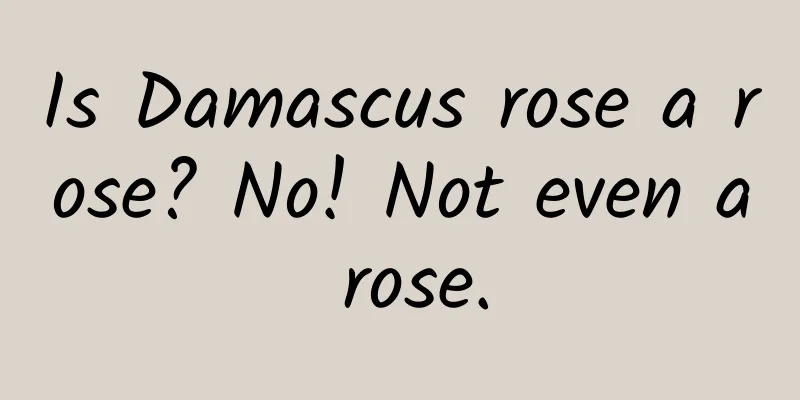Is Damascus rose a rose? No! Not even a rose.

|
Speaking of Damascus, more people may think of the Damascus Rose rather than the capital of Syria. Damascus rose is one of the most famous roses. Rose essential oil and the rose scent in most beauty products come from it. But now, the largest producer of Damascus rose is no longer Syria. Damascus rose, not a rose People in Central Asia believe that the fragrant Damascus rose (Rosa × damascena) is the flower that represents the Prophet Muhammad. Putting aside religious factors, the Damascus rose was indeed cultivated by the hardworking and intelligent Central Asians. Damascus Rose | H. Zell / Wikimedia Commons It is a hybrid of the old French rose (R. x gallica) and the musk rose (R. moschata) from Central Europe; according to the results of molecular research in recent years, the genes of the glandular rose (R. fedtschenkoana) also contributed. The distribution areas of these three species do not overlap, and the hybrid offspring was obtained probably through human efforts. But it can be seen from the hybrid relatives that Damascus rose is not a rose to be exact. It should be called Damascus rose or Turkic rose . Here we have to mention the confusion of roses, Chinese roses, and the rose family. Chinese roses, Chinese roses, and roses refer to different members of the genus Rosa in the Rosaceae family. The word " rose " originally referred to the red jade "fire beads", and later it referred to R. rugosa, which has bright red flowers and rich fragrance; True Rose|Letartean / Wikimedia Commons " Rose " is more complicated. It was originally "Wall Wei" and "Wall Mi", which refers to its climbing stems that grow along the wall, and "Wei" and "Mi" refer to the delicate state of its stems and leaves. Rosa multiflora is a climbing shrub. Σ64 / Wikimedia Commons The name " rose " came later, and was named for its long flowering period and "blooming every month". The scented rose opened the door to a new world of horticultural roses, and the "roses" in flower shops are basically these. The "roses" you see in flower shops are basically hybrid offspring of tea roses|Pixabay However, even if we understand these three Chinese words, we still cannot understand the complicated rose varieties. Different from the common roses and rose varieties nowadays, French roses, Damascus roses and the Centifolia roses mentioned below are called " traditional hybrid roses (Old Garden Roses)". They are rose varieties that appeared in European gardens before the 18th century and have contributed their genes to the cultivation of many modern horticultural varieties. (As for modern varieties, I can only say... goodbye!) The scent of roses spreads from the Middle East to the world In the 12th century, Europeans on their eastward expedition brought the Damascus rose from Syria to Europe , and the plant was thus named after the Damascus rose. What makes Damascus rose famous all over the world is its fragrance and rose essential oil. Rose essential oil, or rose essential oil, is an oily extract of rose petals. Until now, the best quality and most widely used is still the essential oil of Damascus rose . Rose essential oil|Naomi King / flickr When introducing rose essential oils, people always mention how precious they are. Some sources say that it takes 2 to 3 tons of Damascus rose petals to produce 1 kilogram of rose essential oil, so it is called " liquid gold ". Iranians have studied 40 Damascus rose varieties from 13 production areas in Iran, and the oil yield is between 0.15% and 0.35%, which is very precious. There are many aromatic components in rose essential oil, including phenylethyl alcohol, citronellol, linalool, geraniol and nerol, citronellal acetate, etc., and some important trace components, such as rose oxide, β-damascenone, damascenone and β-corone, etc. The relative content of these trace components is only about 1~2%, but they have a strong and typical rose fragrance, and together with the various alcohols and esters mentioned above, they constitute the "skeleton" of the classic rose fragrance. Different origins will bring different "flavors" to Damascus roses. Studies have found that the highest content of rose essential oils from Lebanon is β-phenylethanol and nonadecane, while the highest content of essential oils from Bulgaria is citronellol and geraniol. Therefore, some people have concluded that as the altitude of the origin increases and the climate becomes colder, the content of geraniol and β-phenylethanol in the final rose oil will decrease, while the content of citronellol will increase. Centifolia rosea|Llez / Wikimedia Commons In addition to the rose essential oil from the Middle East, the French and Moroccan centifolia rose (R. × centifolia) can also extract rose essential oil, and its product is usually called French rose essential oil, as a "substitute" for Damascus rose. The aromatic components of centifolia rose are similar to but different from those of Damascus rose. In contrast, the essential oil of centifolia rose is considered to have a sweet scent with a hint of honey. In Shandong, Gansu and other places in China, Pingyin rose (R. rugosa cv 'Plena') and its hybrid bitter water rose (R. sertata x R. rugosa) are also used to extract rose essential oil - the aforementioned are all rose essential oils, and this can be said to be the real rose essential oil. Pingyin rose and bitter water rose have low oil yields, and the essential oils made from them are somewhat different from the essential oils of Damascus rose and centifolia rose in terms of composition and fragrance, and because of the lack of some fixing ingredients, the fragrance lasts for a short time. Therefore, some scholars believe that they are only suitable for use as edible spices. A land of deserts and flowers The city of Damascus once owned roses, and roses once represented Damascus all the way westward, conquering gentlemen and ladies, kings and queens. Damascus and the rose have each other, but they have never been bound by each other. Now, the rose has taken root in nearby countries, becoming the national flower of Iran and the economic pillar of Bulgaria, while Damascus has become the "City of Jasmine". They did not support each other into the future, but only left their marks on each other at a certain moment in history, twisting into a knot. In Iran, picking roses and making rose water is a ritual every May and June|Mostafameraji / Wikimedia Commons If you have ever seen content on social platforms that describes broken walls and ruins as "Syrian style", then these must be the deepest misunderstandings of Syria throughout history. This country has deserts and roses, steel and oil, as well as prosperous and brilliant civilization and art. Syria is located on the eastern coast of the Mediterranean Sea, where the ancient civilizations of the Mesopotamian Basin, ancient Anatolian civilization, and ancient Egyptian civilization intersect. Borders and corridors have always been coexisting with different civilizations, and various powerful nations have competed here. Damascus is the oldest continuously inhabited city in the world . It was inhabited around 8000 BC. In the 12th century BC, the Aramaeans established their capital here and built underground waterways that are still in use today. Damascus then entered the Hellenistic, Roman and Arab eras, and was occupied by the Assyrians, the Babylonian Kingdom, the Persian Empire, the Seleucid Dynasty and the Ptolemaic Dynasty, becoming the cultural center of the Roman Empire and the political center of the Umayyad Dynasty. As one of the end points of the Silk Road, Damascus is also the origin of the English word "damask". Damascus | Bernard Gagnon / Wikimedia Commons Countless nations, countries, and forces have been bustling about competing, creating, and destroying on this land, until the roses of Damascus perfumed the eastern coast of the Mediterranean, until the Arabs brought fragrant floral waters and woven brocades to Europe, and until now. War is not synonymous with this place, but war has been changing it. Just like Damascus and the rose, it has never changed, but it is always changing. References [1] Guenther E, Althausen D. The essential oils[M]. New York: Van Nostrand, 1948. [2] Xiang Jie, Cheng Kai. Basics of Flavor and Fragrance Application Technology[M]. Chemical Industry Press. 2021: [3] Tabaei-Aghdaei SR, Babaei A, Khosh-Khui M, et al. Morphological and oil content variations amongst Damask rose (Rosa damascena Mill.) landraces from different regions of Iran[J]. Scientia Horticulturae, 2007, 113(1): 44-48. [4] Wang Weien, Cao Jiajia, Han Haihong, et al. Analysis of aroma characteristic components of Damascus rose essential oil[J]. Chinese Traditional Patent Medicine, 2021, 43(6):3. [5] Song Jia, Meng Qinghua, Pan Xianhua. Study on the correlation between chemical composition and fragrance characteristics of rose essential oil[J]. Flavor & Fragrance Cosmetics, 2018(1):9. [6] Najem W, El Beyrouthy M, Wakim LH, et al. Essential oil composition of Rosa damascena Mill. from different localities in Lebanon[J]. Acta botanica gallica, 2011, 158(3): 365-373. [7] Misra A, Sharma S, Singh A, et al. Influence of topographic and edaphic factors on rose. II. Flowering quality and quantity[J]. Communications in soil science and plant analysis, 2002, 33(15-18): 2771-2780. [8] Góra J, Lis A, Kalemba D. Chemical composition of the essential oil of Rosa centifolia L. petals[J]. Journal of Essential Oil Research, 1995, 7(1): 89-90. [9] Dobreva A, Nedeltcheva-Antonova D, Nenov N, et al. Subcritical Extracts from Major Species of Oil-Bearing Roses—A Comparative Chemical Profiling[J]. Molecules, 2021, 26(16): 4991. [10] Wang Yaping. Research on the aroma of Pingyin rose[D]. Shanghai University of Technology, 2016. [11] Lei Chunni, Wang Bo, Sun Miaomiao, et al. Analysis of physicochemical indicators and aroma components of bitter water rose essential oil from two origins [J]. Flavor and Fragrance Cosmetics, 2021(4):6. [12] Lu Lehua, Wu Liang, Zhang Ning. Preliminary study on ways to improve the quality of bitter water rose essential oil[J]. Flavor and Fragrance Cosmetics, 2016(5):9. [13] Wang Chenyao, Zhang Qixiang, Luo Le. Study on the meaning of "rose" in ancient China[J]. Chinese Garden, 2021(012):037. [14] Ren Jian. Research on the Imagery and Themes of Roses in Ancient Chinese Literature[D]. Nanjing Normal University, 2019. [15] Wang Chenyao. Study on the traditional Chinese rose culture and rose culture in ancient China[D]. Beijing Forestry University, 2021. [16] Iwata H, Kato T, Ohno S. Triparental origin of Damask roses[J]. Gene, 2000, 259(1-2): 53-59. [17] He Xin. The Hub of History: A New Study on the History and Geography of Central and Western Asia[M]. Modern Publishing House. 2023. Author: 媗媗 This article comes from the Species Calendar, welcome to forward If you need to reprint, please contact [email protected] |
Recommend
Counterpoint: IoT connections using eSIM will reach 2.2 billion by 2030
A recent report on the outlook for IoT connection...
Patients describe themselves: What does it feel like after having two positives? Experts suggest...
Recently, there have been many cases of infection...
Product promotion from 0 to 1: How to acquire seed users?
Today we will introduce in detail how to write co...
Five elements of user reach: materials, channels, and objects!
My definition of user reach is: sending specific ...
Haoxue Weike self-media VIP Baidu network disk sharing teaching courses
The micro-course education course, worth RMB 3,58...
A complete analysis of the Toutiao search account setup and delivery ideas
As a new search platform launched this year, Tout...
Inspirational short film 8 minutes to understand the true meaning of life
Inspirational short film 8 minutes to understand t...
The "trial and error" journey of niche mobile phones
If you want to buy a mobile phone now, you will f...
Tik Tok Promotion: Does Tik Tok win by its algorithm?
Tik Tok is addictive, don't get addicted to i...
Why is this little bird wearing a “black mask”?
A bird's eye view of science Quanzhou Associa...
Douyin promotion: Douyin classification and monetization methods
Tik Tok. A very popular short video APP with a ve...
The latest ranking of 50 information flow advertising media platforms!
Friends who are involved in advertising know that...
How to make an APP marketing plan? Just read this one article!
1. Website promotion 1) Search. Baidu SEM , 360SE...
Douyin Blue V certification is fully open today, sharing 6 core skills for Douyin operations!
Yesterday afternoon, Douyin officially held a mar...
How to use Zhihu ranking to accurately attract traffic and realize monetization from 0 to 1?
Before talking about the ranking principles of Zh...









